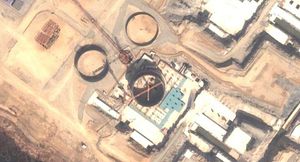North Korea’s rhetoric suggests it’s willing and able to launch nuclear first-strikes on South Korea, Japan, and even the United States. Such rhetoric promotes fear among those who believe that any strikes or retaliation against Pyongyang could lead to a nuclear conflict. But such a North Korean nuclear posture, described as “asymmetric escalation,” is simply not credible during peacetime. Instead, North Korea is on a trajectory to establish a secure second-strike nuclear posture that all but guarantees regime survival and freedom to coerce South Korea from a position of safety.
The prevailing wisdom about North Korean nuclear strategy does not draw a distinction between peace and war. Yet there are reasons to expect that its nuclear strategy would be different under these very different circumstances.
As I discussed last week, it’s highly likely that in the midst of a conflict, North Korea will adopt an asymmetric escalation posture. Not only does North Korea lack the resources to wage a protracted conflict, but there’s a serious possibility that U.S. and South Korean military actions in a conflict — targeting air defenses, amphibious assaults, building up military forces — will inadvertently signal to North Korea that regime change is coming. Whether that’s what the alliance intends to do or not, sending such a signal to North Korea incentivizes them to launch nuclear strikes out of desperation.
But, for all the reasons I articulated last week, such a posture makes little sense in peacetime. North Korea originally pursued nuclear weapons because of regime insecurity, perceiving U.S. nuclear weapons as a kind of trump card that it couldn’t out-escalate.
So why suspect North Korea seeks an assured retaliation capability? Although North Korea lacks sufficient capability for an assured retaliation nuclear posture today, there are several reasons to expect that North Korea is making a deliberate move toward such a peacetime strategy.
First, assured retaliation, especially during peacetime, is the most stable of the various types of nuclear posture because it reserves nuclear use for second-strikes while other posture types incentivize first strikes. It is of course possible to have an assured retaliation capability and be willing to launch nuclear first-strikes, but as a strategy for achieving a political effect, that would equate to an asymmetric escalation strategy, only with a more secure foundation.
Second, North Korea has an incentive not to spark a war that would lead to regime change. An assured retaliation capability guarantees that regime change could not be forced from the outside without nuclear conflict, which in turn conditions U.S. and South Korean decision-making to weigh the cost of nuclear attacks in pursuing regime change.
Third, and perhaps most importantly, while we lack “smoking gun” evidence about North Korean intentions, there are multiple observable North Korean decisions that we would also expect to observe with a state moving toward an assured retaliation strategy. Survivability of a nuclear force has several requirements: geographically dispersed weapons locations; multiple types of nuclear delivery vehicles; and a sufficiently large inventory of nuclear weapons. The “most likely” capability that assures nuclear survivability is a submarine-launched ballistic missile (SLBM) capability because of its mobility and difficulty of detection.
All of these conditions fit with North Korea’s current trajectory. North Korea’s navy is making investments in SLBM technology and modernization of its submarine fleet — a highly expensive undertaking. Its nuclear facilities are not consolidated but spread across at least six locations around the country. And its expected delivery vehicles for nuclear strikes include multiple types of ballistic missiles from multiple missile garrisons, KN-08 road-mobile transporter-erector launchers (TELs), the IL-28 bomber, Soviet era submarines, and surface ships.
Although there is no consensus threshold in the nuclear literature for when survivability is achieved, the nuclear-capable KN-08 and SLBM systems in particular make North Korea’s nuclear force much more survivable.
A nuclear North Korea with an assured retaliation posture is a huge problem for the alliance. As I’ve often recommended (examples here, here, and here), the alliance needs to embrace the prospect of limited war with North Korea. My reasoning was based on the expectation that North Korea would perceive its own assured retaliation posture as allowing it to enact violence against South Korea without serious expectations of regime change, or even retaliation. If that happens, the only way to disabuse North Korea of such a notion without actually waging a nuclear conflict is to be prepared to fight back, but in a controlled manner with limited objectives (i.e., objectives short of regime change).
The status quo allows North Korea to achieve an assured retaliation capability, which in turn heightens the prospects of North Korea coercing South Korea and engaging in nuclear blackmail during any crisis. This shouldn’t be allowed to happen, but nothing is being done to stop it.
To avoid that fate, the alliance is going to be forced to conduct preventive strikes on suspected nuclear sites, or engage in preventive negotiations that freeze and rollback its current trajectory. The window of opportunity for change is closing.

































